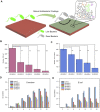Implantable biomedical materials for treatment of bone infection
- PMID: 36793442
- PMCID: PMC9923113
- DOI: 10.3389/fbioe.2023.1081446
Implantable biomedical materials for treatment of bone infection
Abstract
The treatment of bone infections has always been difficult. The emergence of drug-resistant bacteria has led to a steady decline in the effectiveness of antibiotics. It is also especially important to fight bacterial infections while repairing bone defects and cleaning up dead bacteria to prevent biofilm formation. The development of biomedical materials has provided us with a research direction to address this issue. We aimed to review the current literature, and have summarized multifunctional antimicrobial materials that have long-lasting antimicrobial capabilities that promote angiogenesis, bone production, or "killing and releasing." This review provides a comprehensive summary of the use of biomedical materials in the treatment of bone infections and a reference thereof, as well as encouragement to perform further research in this field.
Keywords: biological materials; bone infection; implantable material; multifunctional material; multifunctionalization of materials; progress of infection treatment; treatment of bone infection.
Copyright © 2023 Shuaishuai, Tongtong, Dapeng, Mingran, Xukai, Yue, Hengliang, Guangzhi and Minglei.
Conflict of interest statement
The authors declare that the research was conducted in the absence of any commercial or financial relationships that could be construed as a potential conflict of interest.The authors declare that the research was conducted in the absence of any commercial or financial relationships that could be construed as a potential conflict of interest.
Figures






Similar articles
-
Implantable antimicrobial biomaterials for local drug delivery in bone infection models.Acta Biomater. 2019 Jul 15;93:2-11. doi: 10.1016/j.actbio.2019.01.015. Epub 2019 Jan 14. Acta Biomater. 2019. PMID: 30654212 Free PMC article. Review.
-
Dual-functional 3D-printed composite scaffold for inhibiting bacterial infection and promoting bone regeneration in infected bone defect models.Acta Biomater. 2018 Oct 1;79:265-275. doi: 10.1016/j.actbio.2018.08.015. Epub 2018 Aug 18. Acta Biomater. 2018. PMID: 30125670
-
Allograft Bone as Antibiotic Carrier.J Bone Jt Infect. 2017 Jan 1;2(1):52-62. doi: 10.7150/jbji.17466. eCollection 2017. J Bone Jt Infect. 2017. PMID: 28529864 Free PMC article. Review.
-
Bioengineering Approaches to Fight against Orthopedic Biomaterials Related-Infections.Int J Mol Sci. 2022 Oct 1;23(19):11658. doi: 10.3390/ijms231911658. Int J Mol Sci. 2022. PMID: 36232956 Free PMC article. Review.
-
Current Developments in Antimicrobial Surface Coatings for Biomedical Applications.Curr Med Chem. 2015;22(18):2116-29. doi: 10.2174/0929867321666140916121355. Curr Med Chem. 2015. PMID: 25245508 Review.
Cited by
-
Exploring the Osteoinductive Potential of Bacterial Pyomelanin Derived from Pseudomonas aeruginosa in a Human Osteoblast Model.Int J Mol Sci. 2024 Dec 14;25(24):13406. doi: 10.3390/ijms252413406. Int J Mol Sci. 2024. PMID: 39769171 Free PMC article.
-
Research Progress in Medical Biomaterials for Bone Infections.J Funct Biomater. 2025 May 21;16(5):189. doi: 10.3390/jfb16050189. J Funct Biomater. 2025. PMID: 40422853 Free PMC article. Review.
-
Synthesis and evaluation of nanosystem containing chondroitinase ABCI based on hydroxyapatite.AMB Express. 2024 Feb 14;14(1):23. doi: 10.1186/s13568-024-01677-5. AMB Express. 2024. PMID: 38353777 Free PMC article.
-
Enhancing Bone Grafting Outcomes: A Comprehensive Review of Antibacterial Artificial Composite Bone Scaffolds.Med Sci Monit. 2023 Jul 30;29:e939972. doi: 10.12659/MSM.939972. Med Sci Monit. 2023. PMID: 37516906 Free PMC article. Review.
-
Application of antibiotic bone cement combined with lobulated perforator flap based on descending branch of the lateral circumflex femoral artery in treatment of infected traumatic tissue defects of foot.BMC Musculoskelet Disord. 2024 Aug 27;25(1):673. doi: 10.1186/s12891-024-07810-6. BMC Musculoskelet Disord. 2024. PMID: 39192266 Free PMC article.
References
Publication types
LinkOut - more resources
Full Text Sources

